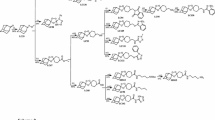Abstract
The antifilarial activity of two coumarin derivatives (A, B) and three glycosyl amine derivatives (D, E, F) was evaluated against a subperiodic strain of human lymphatic filarial parasite Brugia malayi by the intraperitoneal route at 50 mg/kg for 5 consecutive days. Of these, the two sugar derivatives (D and E) were selected for evaluation by the oral route based on their microfilaricidal (mild), macrofilaricidal and female worm sterilization efficacy using the i.p. route of administration. Compound E was finally selected for combination therapy on the basis of its microfilaricidal and embryostatic action by the oral route and its spectrum of activity against micro- and macrofilariae including embryostatic activity by the i.p. route. In addition, E also significantly inhibited the parasite DNA topoisomerase II. Compound A, in contrast, led to an enhanced adult worm burden. Compound B was toxic by the i.p. route, killing all of the treated animals before completion of the experiment. Some of these compounds demonstrated significant antifilarial efficacy of varying degree when tested in vitro Compounds B, D and F also killed adult B. malayi in vitro at 100 μM while 50 μM resulted in very slow motility of worms. Compound E in combination with a promising macrofilaricidal benzopyran derivative reported by us recently (compound C) did not show any synergistic or additive effect. These two compounds (C and E) individually on oral administration with either DEC or ivermectin significantly improved microfilaricidal efficacy in terms of intensity and duration of suppressed microfilaraemia. The combination of DEC with compound E demonstrated marginal enhancement in adulticidal efficacy, however, the embryostatic effect of the duo was significantly higher than that exerted by the individual agents. It may thus be inferred that in the absence of an adulticidal antifilarial drug, the use of potential antifilarials in combination with the standard filaricides may yield better results.







Similar content being viewed by others
References
Casley-Smith JR, Casley-Smith JR (1992) Effect of various combinations of complex physical therapy, benzopyrones and mercury compression on lymphoedema—which combination works best? Excerpta Med Int Congr Ser 994:537–538
Casley-Smith JR, Jamal S, Casley-Smith JR (1993) Reduction of filarial lymphoedema and elephantiasis by 5, 6-benzo-5-pyrone (coumarin), and the effect of diethylcarbamazine (DEC). Am J Trop Med Hyg 87:247–258
Kansas GS (1996) Selectins and their ligands: current concepts and controversies. Blood 88:3259–3287
Karlson KA (1999) Bacterium-host protein-carbohydrate interactions and pathogenicity. Biochem Soc Trans 27:471–474
Katiyar D, Tiwari VK, Tripathi RP, Reddy VM, Misra-Bhattacharya S, Saxena JK (2003) Synthesis and antifilarial evaluation of 7–0-acetamidyl-4-alkyl-2H-1-benzopyran-2-ones. Arzneimittelforschung 53:857–863
Khan AR, Tripathi RP, Bhaduri AP, Sahai R, Puri A, Tripathi LM, Srivastava VML (2001) Synthesis and immunomodulatory activities of 2′-hydroxy-3′-N, N-disubstituted aminopropyl-α-D-glucofuranoses as immunomodulators. Eur J Med Chem 36:103–106
Khan AR, Tripathi RP, Tiwari VK, Mishra RC, Reddy VJM, Saxena JK (2002) Conjugate addition of amines to sugar derived olefinic ester: synthesis of glycosylated amino esters as DNA topoisomerase. II. Inhibitors. J Carbohydr Chem 21:591–604
Misra S, Chatterjee RK, Sen AB (1984) The response of Litomosoides carinii to antifilarial agents in cotton rat Sigmodon hispidus and multimammate rat (Mastomys natalensis). Indian J Med Res 79:749–752
Misra-Bhattacharya S, Katiyar D, Bajpai P, Tripathi RP, Saxena JK (2004) 4-Methyl-7-(tetradecanoyl)-2H-1-benzopyran-2-one: a novel DNA topoisomerase II inhibitor with adulticidal and embryo static activity against sub periodic Brugia malayi. Parasitol Res 92:177–182
Mukherjee M, Misra S, Chatterjee RK (1997) Optimization of test conditions for development of MTT as in vitro screen. Indian J Exp Biol 35:73–76
Mukherjee M, Misra S, Chatterjee RK (1998) Development of in vitro screening system for assessment of antifilarial activity of compounds. Acta Trop 70:251–255
Pandya U, Saxena JK, Kaul SM, Murthy PK, Chatterjee RK, Tripathi RP, Bhaduri AP, Shukla OP (1999) DNA topoisomerases of filarial parasites: effect of antifilarial compounds. Med Sci Res 27:103–106
Sacchetani JC (2001) Multivalent protein carbohydrate interactions. A new paradigm for supermolecular assembly and signal transduction. Biochemistry 40:3009–3015
Singh U, Misra S, Murthy PK, Katiyar JC, Agrawal A, Sircar AR (1997) Immunoreactive molecules of Brugia malayi and their diagnostic potential. Serodiag Immunother Infect Dis 8:207–212
Tripathi RP, Tripathi R, Bhaduri AP, Singh SN, Chatterjee RK, Murthy PK (2000) Antifilarial activity of some 2H-1-benzopyran-2-ones (coumarins). Acta Trop 76:101–106
Tripathi RP, Saxena JK, Shukla OP, Chandra S, Murthy PK, Bhattacharya S, Kamboj KK, Dwivedi AK, Chatterjee RK, Singh S, Srivastava VML, Rastogi AK, Bhaduri AP (2001) A process for the preparation of novel 4-alkyl-7–0-(acetamid-2-yl)-2H-1-benzopyran-2-ones useful as inhibitors of helminthic and protozoan DNA topoisomerases. Indian Patent Application 620/DEL/01
Tripathi RP,Tripathi R, Tiwari V K, Bala L, Sinha S, Srivastava A, SrivastavaR, Srivastava BS (2002) Synthesis of glycosylated β-amino acids as new class of antitubercular agents. Eur J Med Chem 37:773–781
Tripathi RP, Tiwari VK, Misra-Bhattacharya S, Tyagi K, Srivastava VML, Murthy PK (2003) 7-O-[4-methyl piperazine-1-(2-acetyl)] 2 H-1-benzopyran-2-one: a novel antifilarial lead compound. Acta Trop 87:193–202
Vacqier VD, Moy GW (1997) The fucose sulphate polymer of egg jellybinds to sperm REJ and is the inducer of the sea urchin sperm acrosome reaction. Dev Biol 192:125–135
Acknowledgements
The technical assistance provided by Mr. A.K. Roy and Mr. R.N. Lal is duly acknowledged. We are also thankful to Dr. S.K. Mandal, Biometry Division, for his help in the statistical analysis of the data. Financial assistance from the Department of Science and Technology, Delhi, India in the form of a research fellowship to one of us (S.K.V.) is gratefully acknowledged. The communication no. allotted to this manuscript is 6709.
Author information
Authors and Affiliations
Corresponding author
Rights and permissions
About this article
Cite this article
Bajpai, P., Verma, S.K., Katiyar, D. et al. Search for new prototypes for the chemotherapy of filariasis: a chemotherapeutic and biochemical approach. Parasitol Res 95, 383–390 (2005). https://doi.org/10.1007/s00436-004-1295-1
Received:
Accepted:
Published:
Issue Date:
DOI: https://doi.org/10.1007/s00436-004-1295-1




